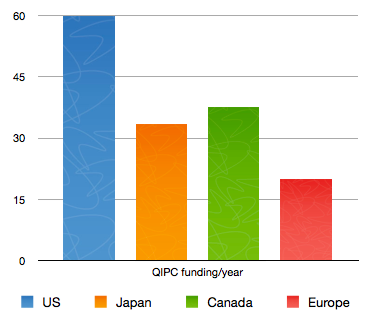3.5 QIPC research in the international context
Quantum information processing has become a scientific discipline with its own identity during the last ten years. The advent of quantum cryptography in the 80s and then the recognition of quantum computing in the 90s, for example using Shor’s algorithm, provided the motivation and have been the starting point of serious experimental and theoretical efforts to realize QIPC at large.
Through the activities of the FET proactive initiatives in FP5, FP6 and now FP7, Europe has, in the main, been at the leading edge of QIS worldwide. The early spearheading of this high-risk R&D effort by the EC has aided in the creation of a number of national investments in QIS with the research area now reaching a more mature stage of medium/high risk. Until now, European publication output and quality has been on a par (and even superior) with the US, while other nations have begun systematic ramp-up in QIS investments.
In the last years, significant growths in the research efforts within the field of QIST have been made worldwide. Especially the US has fostered their research activities, supported by a number of public funding agencies (for example the National Science Foundation and the Defense Advanced Research Projects Agency). To retain our leading position in research and to capitalize on the Commission’s already significant investments in QIS (50M€ in FP5 and FP6, 45M€ in FP7), it is vital to ensure that the EU investment in QIS remains competitive with the US and other national/continental QIS investors.
In the figure below we plot the 2008 funding figures in the QIPC area for the US, Canada, Japan and Europe. QIS R&D support on the scale of ~15M€/year puts Europe below average of worldwide QIS funding support. With such a potential decrease in international competitiveness, there is considerable risk that European research in QIS and the resulting technology developments (commercial and defense), will not be sustainable, leaving Europe reliant on importing such developed QIS technology from abroad.

QIPC funding/year in the US, Japan, Canada and Europe. We take only into account the money spent according to a coordinated joint programming agenda (that is national funding is not kept into acount)

